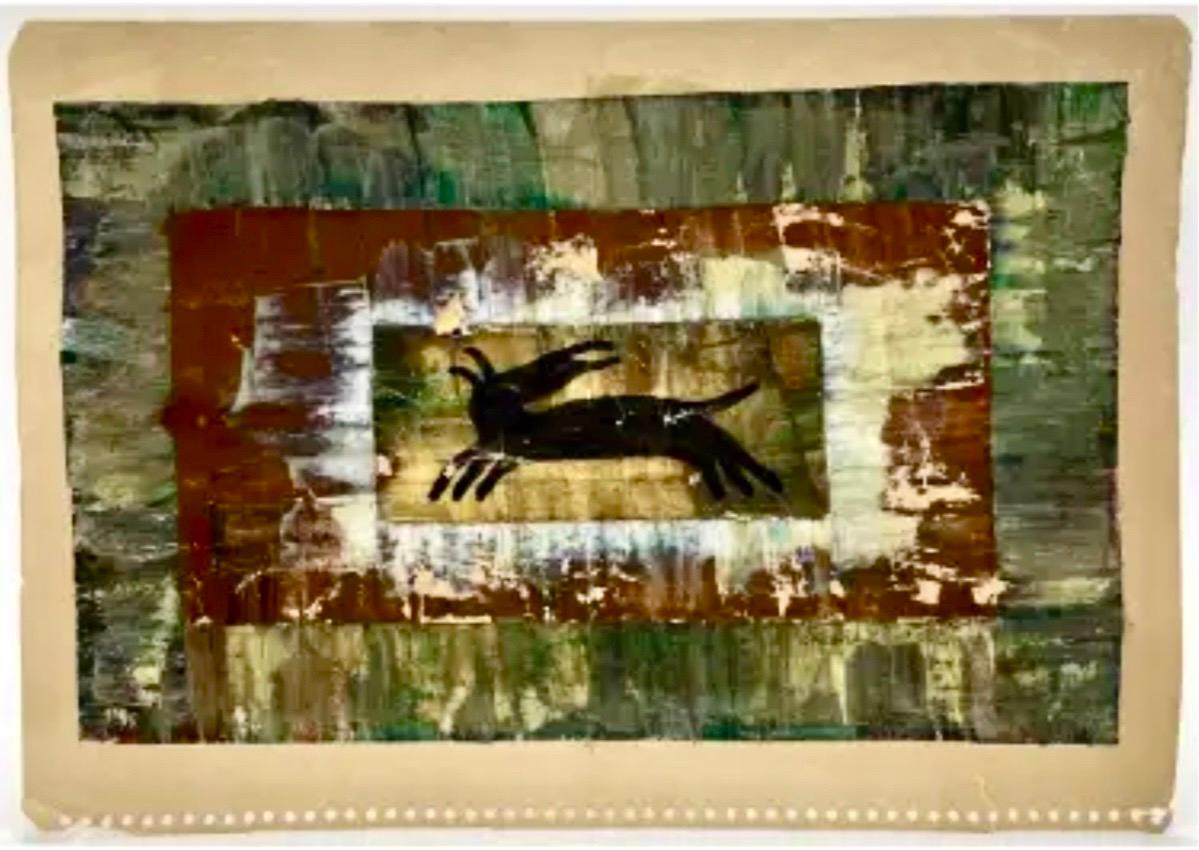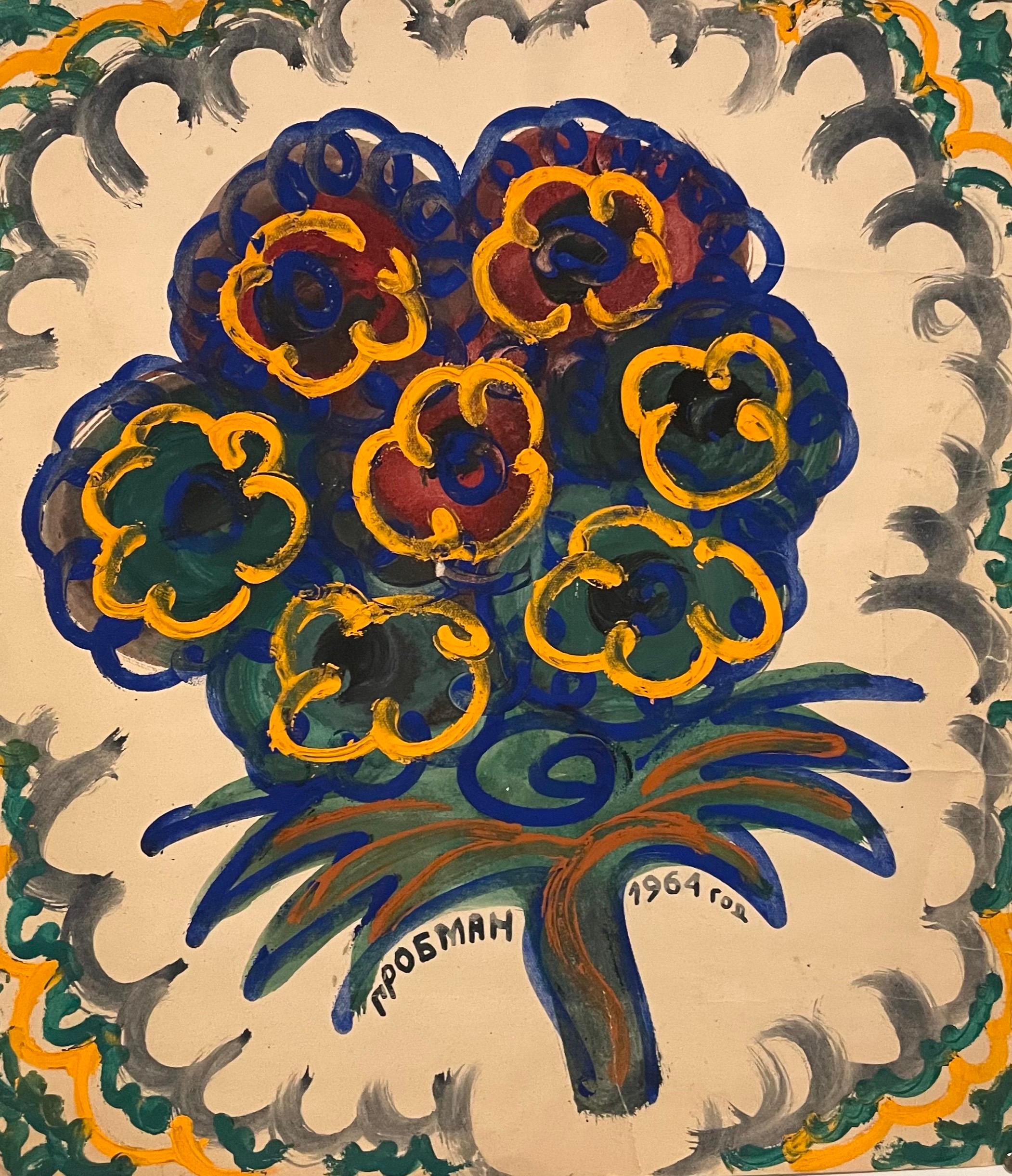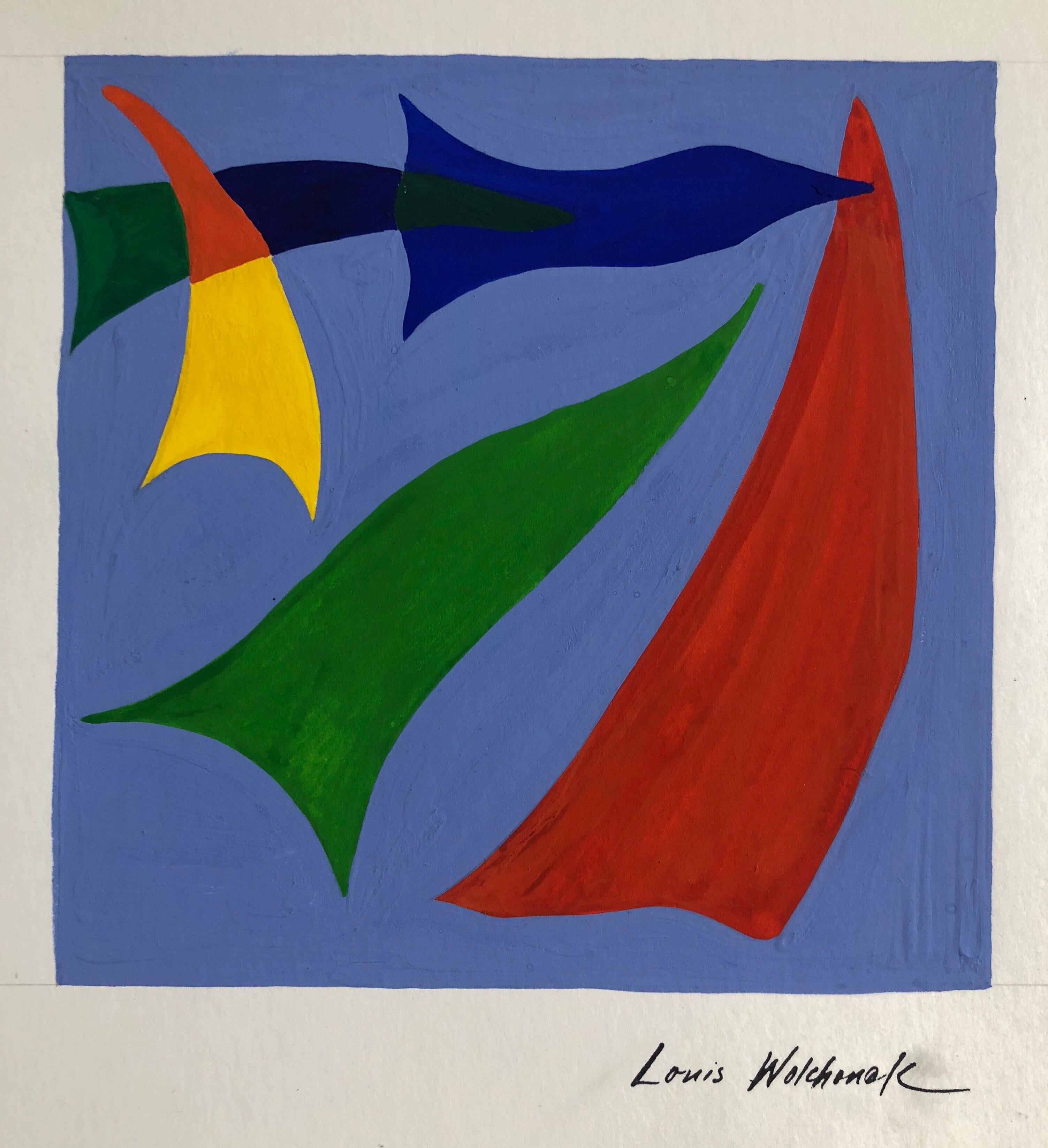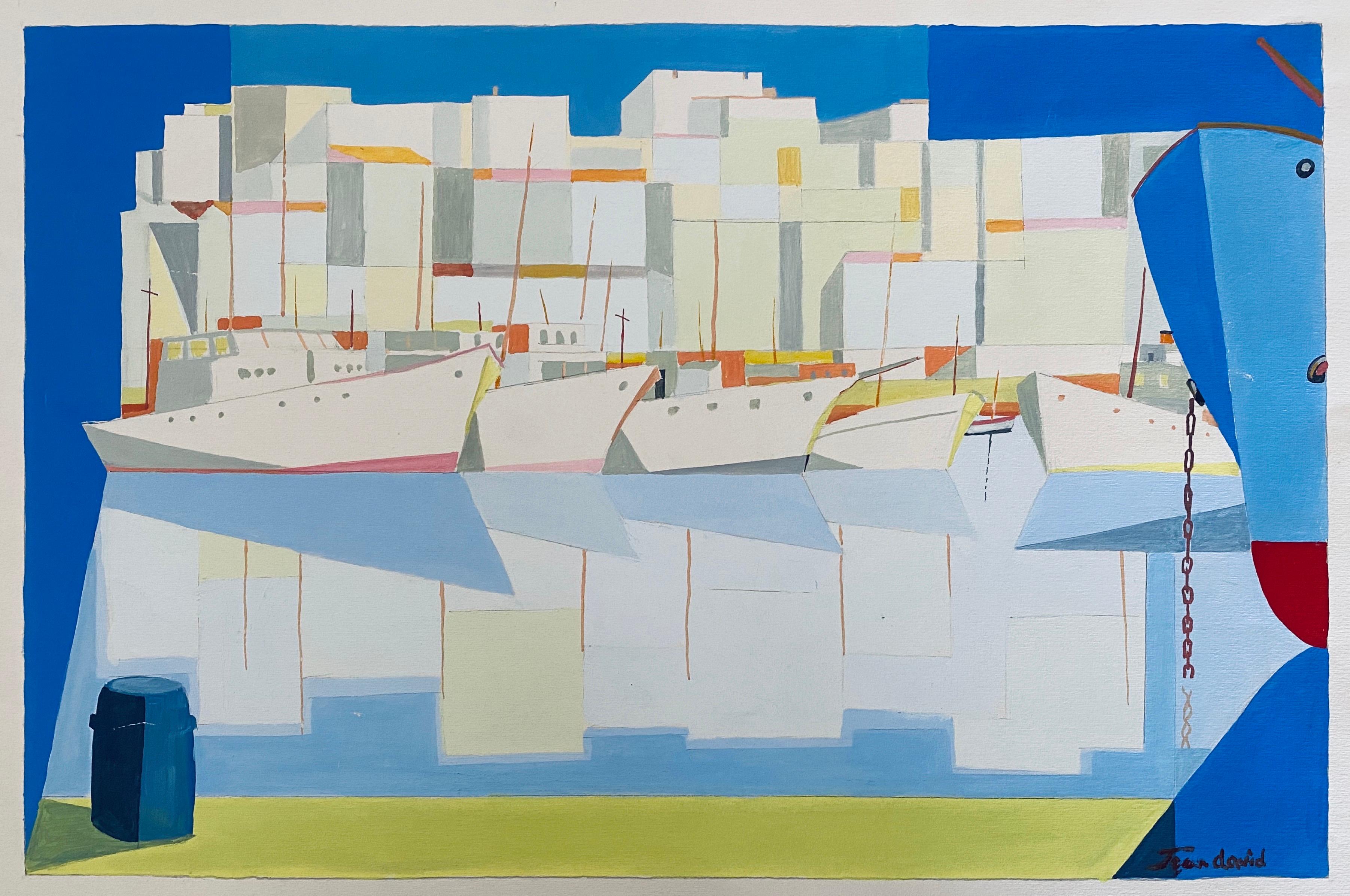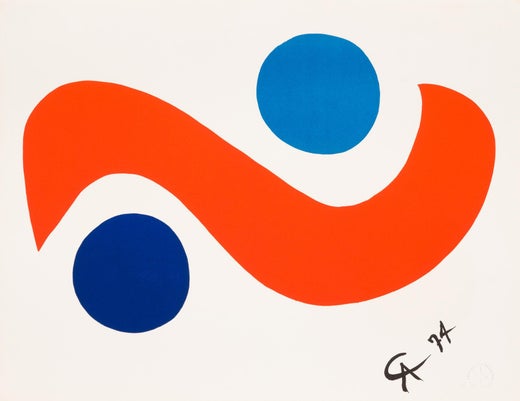Alexander CalderLarge Black Face With Sun, 19681968
1968
About the Item
- Creator:Alexander Calder (1898 - 1976, American)
- Creation Year:1968
- Dimensions:Height: 39.38 in (100.03 cm)Width: 53.38 in (135.59 cm)
- Medium:
- Movement & Style:
- Period:
- Condition:Generally very good condition - 2 small spots of inpainting in the white areas, invisible to the eye, only visible under UV.
- Gallery Location:Greenwich, CT
- Reference Number:
Alexander Calder
The American sculptor Alexander Calder is known as the father of the mobile, a moving artwork composed of delicately balanced sculptural forms suspended from the ceiling.
Because Calder's parents, both artists themselves, did not want him to suffer the hardships of trying to make a living in art, they encouraged the young Calder to study mechanical engineering at the Stevens Institute of Technology, in Hoboken, New Jersey. He worked a number of jobs, including as a hydraulic engineer and draftsman for the New York Edison Company, before deciding to pursue an artistic career. He never abandoned his engineering background, however, applying his understanding of gears and moving parts in all his artworks, from mechanical toys like the Cirque Calder (1931) and his revered prints to his free-standing abstract sculptures, called stabiles.
In 1926, Calder moved to Paris and established a studio in the Montparnasse quarter. He began creating the many parts of his famous miniature circus from found materials, such as wire, string, cloth, rubber and cork. Designed to be transportable, Cirque grew to fill five suitcases over the years. Always interested in putting forms in motion, Calder also pioneered a new art form called wire sculptures, which he described as “drawings in space.” Like his famous mobiles, the wire sculptures were suspended so that they turned with any movement of the air, presenting different forms when viewed from different angles.
In the 1950s, Calder returned to his roots in mechanical engineering, creating monumental abstract sculptures that verged on the architectural. He worked from loose gestural drawings like this preparatory sketch for his Man Stabile, from 1966. Throughout his career, he also worked as a set designer for the theater, as well as an illustrator and printmaker, producing vibrant, whimsical drawings for books and journals.
Find original Alexander Calder art today on 1stDibs.
- ShippingRetrieving quote...Ships From: New York, NY
- Return PolicyA return for this item may be initiated within 3 days of delivery.
- Bowling, 1974By Alexander CalderLocated in Greenwich, CTBowling gouache and ink on paper 29.5 x 43.25" signed and dated "Calder 74" on recto, lower right This work is registered in the archives of the Calder Foundation, New York. LITERA...Category
20th Century Modern Paintings
MaterialsPaper, Gouache
- Untitled, 1982 (SF82-254)By Sam FrancisLocated in Greenwich, CTUntitled (SF82-254) from 1982 is an acrylic painting on paper, with an image size of 19.5 x 13.25 inches, signed and dated 'Sam Francis 1982' verso, a...Category
20th Century Abstract Paintings
MaterialsPaper, Acrylic
- Bright Web, 1973 (SF73-5)By Sam FrancisLocated in Greenwich, CTBright Web is an acrylic on paper painting with an image size of 22 x 30 inches, signed and dated verso 'Sam Francis 1973 Tokyo' and framed in a custom, closed-corner, gold-leaf fram...Category
20th Century Abstract Paintings
MaterialsPaper, Acrylic
- Untitled, 1970 (SF68-44)By Sam FrancisLocated in Greenwich, CTUntitled (SF68-44) from 1970 is an acrylic painting on paper with an image size of 41 x 27.5 inches, signed and dated 'Sam Francis 1970' verso, and framed in a custom, closed-corner,...Category
20th Century Abstract Paintings
MaterialsPaper, Acrylic
- Untitled, 1980 (SF80-107)By Sam FrancisLocated in Greenwich, CTUntitled, 1980 (SF80-107) is an acrylic painting on paper, signed and dated 'Sam Francis 1980' verso and framed in a contemporary, closed-corner, gold leaf frame. Painted to the edge...Category
20th Century Abstract Paintings
MaterialsPaper, Acrylic
- Untitled, 1963 (SF63-039)By Sam FrancisLocated in Greenwich, CTUntitled (SF63-039) is an acrylic painting on paper, with an image size of 41 x 27.5 inches, signed 'Sam Francis' verso, and framed in a contemporary light wood frame. Untitled, 196...Category
20th Century Abstract Paintings
MaterialsPaper, Acrylic
- Untitled [Abstraction]By George L.K. MorrisLocated in New York, NYGouache on paper, 18 7/8 x 14 3/4 in. Signed (at lower right): Morris; (with monogram, on the back): GLKM [monogram] / 1932 [sic] Executed circa late 1940s A passionate advocate of abstract art during the 1930s and 1940s, George L. K. Morris was active as a painter, sculptor, editor, and critic. An erudite man with an internationalist point of view, Morris eschewed the social, political, and figural concerns that preoccupied so many artists of Depression-era America, believing that painters should focus their attention on the beauty, refinement, and simplicity of pure form instead. His goal, he said, was “to wedge the expression further and further into the confines of the canvas until every shape takes on a spatial meaning” (as quoted in Ward Jackson, “George L. K. Morris: Forty Years of Abstract Art,” Art Journal 32 [Winter 1972–73], p. 150). Born into an affluent family in New York City, Morris was a descendent of General Lewis Morris, a signer of the Declaration of Independence. From 1918 until 1924, he attended the Groton School in Connecticut, studying classics and art. He continued to focus on literature and art while attending Yale University (1924–28), an experience that prepared him well for his future activity as an artist-critic. After graduating in 1928, Morris studied at the Art Students League of New York, working under the realist painters John Sloan and Kenneth Hayes Miller, as well as Jan Matulka, the only modernist on the faculty. In the spring of 1929, Morris traveled to Paris with Albert E. Gallatin, a family friend and fellow painter who introduced him to leading members of the Parisian avant-garde, including Jean Arp, Pablo Picasso, Georges Braque, Jean Hélion, and Piet Mondrian. Morris also took classes at the Académie Moderne, studying under Fernand Léger and Amédée Ozenfant, important exponents of Synthetic Cubism who influenced his aesthetic development. Indeed, after experimenting with the simplified forms of Modernism for a few years, Morris moved on to abstraction by 1934, adopting a hard-edged, geometric approach inspired by Leger’s cubist style and the biomorphic shapes of Arp and Joan Miró. Following his return to New York in 1930, Morris built a white-walled, open-spaced studio (inspired by that of Ozenfant, which had been designed by Le Corbusier) on the grounds of Brockhurst, his parents’ 46-acre estate in Lenox, Massachusetts. In 1935, he married the painter and collagist Estelle “Suzy...Category
1940s American Modern Abstract Paintings
MaterialsPaper, Gouache
- Post Soviet Avant Garde Russian Israeli Gouache Collage Painting GrobmanBy Michail GrobmanLocated in Surfside, FLMichail Grobman (Russian: Михаил Гробман, Hebrew: מיכאיל גרובמן, born 1939) is an artist and a poet working in Israel and Russia. He is father to Hollywood producer Lati Grobman and Israeli architect Yasha Jacob Grobman. Biography 1939 – Born in Moscow. 1960s – Active member of The Second Russian Avant-Garde movement in the Soviet Union. 1967 – Member of Moscow Artists Union. 1971 – Emigrates to Israel and settles in Jerusalem. 1975 – Founded the Leviathan group and art periodical (in Russian). Since 1983, he lives and works mainly in Tel Aviv. Awards In 2001, Grobman was a co-recipient of the Dizengoff Prize for Painting. Solo exhibitions 2007 – Last Skies, Loushy & Peter Art & Projects, Tel Aviv (cat. text: Marc Scheps) 2006 – Creation From Chaos to Cosmos, Bar-David Museum of Fine Art and Judaica, Kibbutz Baram (cat. text: Sorin Heller) 2002 – The Last Sky, installation, Tsveta Zuzoritch pavilion, Belgrad (cat. text: Irina Subotitch) 1999 – Mikhail Grobman: Works 1960–1998, The State Russian Museum, St. Petersburg (cat. texts: Evgenija Petrova, Marc Scheps, Lola Kantor-Kazovsky, Michail German) Michail Grobman was born in Moscow. He grew up writing poetry, essays and literary prose. In the 1960s, he was active in the Second Russian Avant-garde movement in the Soviet Union. In 1971, he immigrated to Israel. In 1975, he established the Leviathan school together with Avraham Ofek and Shmuel Ackerman, seeking to combine symbolism, metaphysics and Judaism in an all-inclusive “national style.” Grobman’s lithograph work employs images and symbols from Jewish mysticism and Kabbalah. His paintings incorporate texts in Russian and Hebrew. In addition to his artistic endeavors, he writes about art and aesthetics. The group combined conceptual art and "land art" with Jewish symbolism. Of the three of them Avraham Ofek had the deepest interest in sculpture and its relationship to religious symbolism and images. In one series of his works Ofek used mirrors to project Hebrew letters, words with religious or cabbalistic significance, and other images onto soil or man-made structures. In his work "Letters of Light" (1979), for example, the letters were projected onto people and fabrics and the soil of the Judean Desert. In another work Ofek screened the words "America", "Africa", and "Green card" on the walls of the Tel Hai courtyard during a symposium on sculpture Part of the generation of emigre Russian artists, many Jewish, that included Yuri Kuper, Komar and Melamid, Eduard Steinberg, Erik Bulatov, Viktor Pivovarov, Vladimir Yankilevsky, Ilya Kabakov and Grisha Bruskin. Date of Birth: 1939, Moscow 1960s Active member of The Second Russian Avant Garde 1967 Member of the Moscow Painters Association 1971 Immigrated to Israel and settled in Jerusalem 1975 Founded the Leviathan group and art periodical (in Russian) Since 1983 Lives and works in Tel Aviv . Selected Solo Exhibitions: 2002 Pavilion Zveta Zuzovich, "The Last Sky", Belgrad (cat: Irena Subotitch) 1999 The State Russian Museum, ST. Petersburg 1998 "Picture = Symbol + Concept", Herzliya Museum of Art, Herzliya 1995 "Password and Image", University Gallery, Haifa University 1990 Tova Osman Gallery, Tel Aviv 1989 "The Beautiful Sixties in Moscow", The Genia Schreiber University Art Gallery, Tel Aviv University (with llya Kabakov; cat. text: Mordechai Omer] Spertus Museum, Chicago Beit Rami and Uri Nechushtan, Ashdot Yaacov (leaflet) 1972 Nora Gallery, Jerusalem 1973 - Negev Museum, Beer Sheva 1971 Tel Aviv Museum of Art (cat. text: Haim Gamzu) 1966 Mos-lng-Projekt, Moscow 1965 Artist's House, Moscow Energy Institute, Moscow History Institute, Moscow Usti-nad-Orlicy Theatre,Czechoslovakia (leaflet text: Dushan Konetchni) 1959 Mukhina Art Institute, Leningrad . Selected Group Exhibitions: 2003 "Yes do yourself...", Regeneration of Judaism in Israeli art, Zman Omanut Tel Aviv (cat: Gideon Ofrat) 1999 "Russian post-war avantgarde", The Trajsman Collection in the State Russian Museum, St. Petersburg Tretjakov National Gallery, Moscow (cat. text: Yevgenij Barabanov, John...Category
1960s Modern Mixed Media
MaterialsPaper, Watercolor, Gouache
- Post Soviet Nonconformist Avant Garde Russian Israeli Gouache Painting GrobmanBy Michail GrobmanLocated in Surfside, FLMIchail Grobman Gouache and watercolor on paper Hand signed Lower Left and Dated 1964. Described inn Cyrillic Russian verso. Dimensions: L:13.25" W: 11.75". Michail Grobman (Russian: Михаил Гробман, Hebrew: מיכאיל גרובמן, born 1939) is an artist and a poet working in Israel and Russia. He is father to Hollywood producer Lati Grobman and Israeli architect Yasha Jacob Grobman. Biography 1939 – Born in Moscow. 1960s – Active member of The Second Russian Avant-Garde movement in the Soviet Union. 1967 – Member of Moscow Artists Union. 1971 – Emigrates to Israel and settles in Jerusalem. 1975 – Founded the Leviathan group and art periodical (in Russian). Since 1983, he lives and works mainly in Tel Aviv. Awards In 2001, Grobman was a co-recipient of the Dizengoff Prize for Painting. Solo exhibitions 2007 – Last Skies, Loushy & Peter Art & Projects, Tel Aviv (cat. text: Marc Scheps) 2006 – Creation From Chaos to Cosmos, Bar-David Museum of Fine Art and Judaica, Kibbutz Baram (cat. text: Sorin Heller) 2002 – The Last Sky, installation, Tsveta Zuzoritch pavilion, Belgrad (cat. text: Irina Subotitch) 1999 – Mikhail Grobman: Works 1960–1998, The State Russian Museum, St. Petersburg (cat. texts: Evgeniya Petrova, Marc Scheps, Lola Kantor-Kazovsky, Michail German) Michail Grobman was born in Moscow. He grew up writing poetry, essays and literary prose. In the 1960s, he was active in the Second Russian Avant-garde movement in the Soviet Union. In 1971, he immigrated to Israel. In 1975, he established the Leviathan school together with Avraham Ofek and Shmuel Ackerman, seeking to combine symbolism, metaphysics and Judaism in an all-inclusive “national style.” Grobman’s lithograph work employs images and symbols from Jewish mysticism and Kabbalah. His paintings incorporate texts in Russian and Hebrew. In addition to his artistic endeavors, he writes about art and aesthetics. The group combined conceptual art and "land art" with Jewish symbolism. Of the three of them Avraham Ofek had the deepest interest in sculpture and its relationship to religious symbolism and images. In one series of his works Ofek used mirrors to project Hebrew letters, words with religious or cabbalistic significance, and other images onto soil or man-made structures. In his work "Letters of Light" (1979), for example, the letters were projected onto people and fabrics and the soil of the Judean Desert. In another work Ofek screened the words "America", "Africa", and "Green card" on the walls of the Tel Hai courtyard during a symposium on sculpture Part of the generation of emigre Russian artists, many Jewish, that included Yuri Kuper, Komar and Melamid, Eduard Steinberg, Erik Bulatov, Viktor Pivovarov, Vladimir Yankilevsky, Ilya Kabakov and Grisha Bruskin. Date of Birth: 1939, Moscow 1960s Active member of The Second Russian Avant Garde 1967 Member of the Moscow Painters Association 1971 Immigrated to Israel and settled in Jerusalem 1975 Founded the Leviathan group and art periodical (in Russian) Since 1983 Lives and works in Tel Aviv . Selected Solo Exhibitions: 2002 Pavilion Zveta Zuzovich, "The Last Sky", Belgrad (cat: Irena Subotitch) 1999 The State Russian Museum, ST. Petersburg 1998 "Picture = Symbol + Concept", Herzliya Museum of Art, Herzliya 1995 "Password and Image", University Gallery, Haifa University 1990 Tova Osman Gallery, Tel Aviv 1989 "The Beautiful Sixties in Moscow", The Genia Schreiber University Art Gallery, Tel Aviv University (with llya Kabakov; cat. text: Mordechai Omer] Spertus Museum, Chicago Beit Rami and Uri Nechushtan, Ashdot Yaacov (leaflet) 1972 Nora Gallery, Jerusalem 1973 - Negev Museum, Beer Sheva 1971 Tel Aviv Museum of Art (cat. text: Haim Gamzu) 1966 Mos-lng-Projekt, Moscow 1965 Artist's House, Moscow Energy Institute, Moscow History Institute, Moscow Usti-nad-Orlicy Theatre,Czechoslovakia (leaflet text: Dushan Konetchni) 1959 Mukhina Art Institute, Leningrad . Selected Group Exhibitions: 2003 "Yes do yourself...", Regeneration of Judaism in Israeli art, Zman Omanut Tel Aviv (cat: Gideon Ofrat) 1999 "Russian post-war avantgarde", The Trajsman Collection in the State Russian Museum, St. Petersburg Tretjakov National Gallery, Moscow (cat. text: Yevgenij Barabanov, John Bolt...Category
1960s Modern Abstract Paintings
MaterialsPaper, Watercolor, Gouache
- Early Abstract Expressionist Gouache Painting WPA Jewish ArtistBy Louis WolchonokLocated in Surfside, FLLouis Wolchonok was a social realist painter and member of the Woodstock Art Association. His work was exhibited at the Whitney Museum of American Art, the National Academy of Design...Category
20th Century Modern Abstract Paintings
MaterialsPaper, Gouache
- Early Abstract Expressionist Oil Painting Monoprint WPA Jewish ArtistBy Louis WolchonokLocated in Surfside, FLLouis Wolchonok was a social realist painter and member of the Woodstock Art Association. His work was exhibited at the Whitney Museum of American Art, the National Academy of Design...Category
20th Century Modern Abstract Paintings
MaterialsPaper, Gouache
- Romanian Modernist Gouache Painting Of Buildings And Boats - Jean DavidBy Jean DavidLocated in Surfside, FLJean David was a painter and designer, known for his contributions to the Romanian avant-garde and to the early modernist art of Israel (then recently founded). He was the first Israeli artist to be inducted into the illustrious Alliance Graphique Nationale in 1954. He had studied between 1927 and 1937 at various art academies in Paris. In 1929 he participated for the first time at a collective exhibition in Bucharest and in 1933 he had his first personal exhibition (in the same city). In the early '30s he was a member of the Surrealist group "unu" (meaning "one"). In 1942, he left Romania in a boat with 12 other Jews, including Theodor Brauner, the brother of Victor Brauner. After being captured by British authorities in Cyprus, he managed to reach Palestine in 1944. In 1949 he went to live in Jerusalem, where he was active in developing ceramic arts, sculpture works in copper, and artistic tapestry wall hangings under the auspices of the Ministry of Trade and Industry. Together with Marcel Janco, he founded in Israel the artist village known as Ein Hod. He also gained much reputation as a muralist and graphic and poster designer, having designed numerous posters and other works for the El Al air company, Maccabiah games, Zim shipping and The Israel tourist industry. David’s primary importance was in the design of posters. He used a wildly colorful decorative style in his art, which combined illustration, caricature, and national figures. In addition he designed wall hangings for “Maskit,” and also worked in the decoration of public buildings. His paintings had elements of Surrealism and included images from nature and landscapes. Similar in style to David Klein and the Polish Cyrk posters. Forms From Israel, Mounting Exhibition, USA, 1958 Artists: El Hanani (Sapozhnikow), Arie Azaz, Nehemiah Boris Carmi, Hanna Harag Zunz, David, Jean David Gumbel, Keiner Forcheimer, Julia Mansfeld, Al Merom, Peter Mayer, Jean Palombo...Category
Mid-20th Century Modern Figurative Paintings
MaterialsGouache, Paper
Recently Viewed
View AllRead More
Renowned for His Mobiles, Alexander Calder Was Also Adept at Crafting Modernist Jewelry
There are no sparkling gemstones on this necklace, but its value far exceeds the cost of its materials.
10 Must-Visit American Public Sculptures
Get your dose of Vitamin D while surveying works by the likes of Alexander Calder, Keith Haring and Pablo Picasso.
![Untitled [Abstraction]](https://a.1stdibscdn.com/george-lk-morris-1905-1975-american-paintings-untitled-abstraction-for-sale/a_23/1652214284908/APG_8941_unfr_master.jpg)
